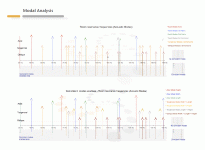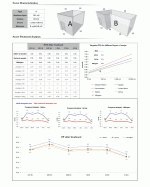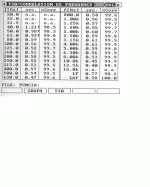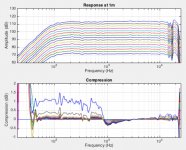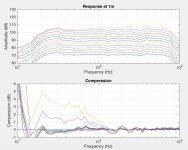With my system & room (single 15" woofer in 60cm-wide box, placed right up against the front wall), and without any baffle step compensation at all in the passive crossover, by averaging the Left and Right speaker responses (*) I get a relatively smooth 6dB "shelf" lift below ~100Hz, which sounds just about right with most recordings (cf. Olive et al., "Listener Preferences for In-Room Loudspeaker and Headphone Target Responses").
It's a relief to me to see some actual measurements and not the same-old "it sounds good to me" stuff. In this day-and-age it baffles me how people can still use subjective listening as a design guide.
I also agree with the target curve.
Hello!
I am really wondering seeing so much frequency responses "obviously" measured in the corresponding listening room... How did all of you manage this??
From my understanding a measurement in one shot is not possible in most situations (listening rooms). See here for explainations:
http://www.audiomatica.com/wp/wp-content/uploads/CLIO-Pocket-Review.pdf
So, the only way to get correct results is a log chirp with windowing out the reflections. This will invalidate the measurement below a certain frequency.
One "correct" methos is described in the review.
Baffle step. Yes, we have an baffle step effect. Wa cannot discuss this away down to null
And additionally, woofer surface cannot be replaced by something else. You need a certain woofer surface to yield realistic bass. Think of an 6 inch driver in an infinite wall. There is no baffle step but also no realistic bass.
Furthermore, if you reach a realistic region for reproducing bass, resonances are lurking in every corner: the chassis itself, the cabinet, the room.
In my opinion, because of all this, the best way is to have an driver with self resonance in the range of 20 Hz or below, an open baffle and an acoustically treated room in order to tame room resonaces and room modes. Room modes (fundamental and higher order modes are an really interesting topic!) And an crossover that let the lower chassis "fill up" what the upper woofer is missing with respect to a flat response. This is my solution:
Non Compromising Open Baffle - wolfvonlanga
My method was to measure the near field response in the cabinet of the middle woofer and the HF part, export the measurements to an good simulation program like Boxsim, tune the crossover-parameters and at the end do an rough measurement cross-check at certain microphone positions. But be aware that reflections and comb filter effects have to be considered well or estimated or tamed with help of damping material but this is hard to deal for lower frequencies.
I am really wondering seeing so much frequency responses "obviously" measured in the corresponding listening room... How did all of you manage this??
From my understanding a measurement in one shot is not possible in most situations (listening rooms). See here for explainations:
http://www.audiomatica.com/wp/wp-content/uploads/CLIO-Pocket-Review.pdf
In the absence of an anechoic chamber, loudspeaker response measurements will invariably be corrupted by later arriving reflections from nearby surfaces.
So, the only way to get correct results is a log chirp with windowing out the reflections. This will invalidate the measurement below a certain frequency.
One "correct" methos is described in the review.
Baffle step. Yes, we have an baffle step effect. Wa cannot discuss this away down to null
And additionally, woofer surface cannot be replaced by something else. You need a certain woofer surface to yield realistic bass. Think of an 6 inch driver in an infinite wall. There is no baffle step but also no realistic bass.
Furthermore, if you reach a realistic region for reproducing bass, resonances are lurking in every corner: the chassis itself, the cabinet, the room.
In my opinion, because of all this, the best way is to have an driver with self resonance in the range of 20 Hz or below, an open baffle and an acoustically treated room in order to tame room resonaces and room modes. Room modes (fundamental and higher order modes are an really interesting topic!) And an crossover that let the lower chassis "fill up" what the upper woofer is missing with respect to a flat response. This is my solution:
Non Compromising Open Baffle - wolfvonlanga
My method was to measure the near field response in the cabinet of the middle woofer and the HF part, export the measurements to an good simulation program like Boxsim, tune the crossover-parameters and at the end do an rough measurement cross-check at certain microphone positions. But be aware that reflections and comb filter effects have to be considered well or estimated or tamed with help of damping material but this is hard to deal for lower frequencies.
Room analysis and treatment
Only to show how complex room treatment is.
Analysis and treatment of the room. Only in this way it is possible to assess ANY reliable and extrapolatable difference in speaker sound!
So, if you do not have treated your room in this way and you show an simple FFT analysis without any windowing of the impulse respose or your speaker I will not believe the results
Only to show how complex room treatment is.
Analysis and treatment of the room. Only in this way it is possible to assess ANY reliable and extrapolatable difference in speaker sound!
So, if you do not have treated your room in this way and you show an simple FFT analysis without any windowing of the impulse respose or your speaker I will not believe the results
Attachments
Last edited:
They are just different ways of measuring that are useful for different purposes.
Post #14552 is windowed to remove reflections. Since it is in room the window is fairly short (probably 3 ms) so no useful information below the midrange.
Post #14558 is near field without smoothing.
Post #14560 is not windowed on purpose to include the effect of the room gain and reflections. This one is heavily smoothed.
It can be useful to play pink noise and move the microphone around with a real-time analyzer to search for localized issues in the room.
For crossover work around 700 Hz I liked to measure outside with the speaker off the ground so a longer time window can be used.
Haven't gotten into room treatment yet...
That 'Non Compromising Open Baffle - wolfvonlanga' is original.
Post #14552 is windowed to remove reflections. Since it is in room the window is fairly short (probably 3 ms) so no useful information below the midrange.
Post #14558 is near field without smoothing.
Post #14560 is not windowed on purpose to include the effect of the room gain and reflections. This one is heavily smoothed.
It can be useful to play pink noise and move the microphone around with a real-time analyzer to search for localized issues in the room.
For crossover work around 700 Hz I liked to measure outside with the speaker off the ground so a longer time window can be used.
Haven't gotten into room treatment yet...
That 'Non Compromising Open Baffle - wolfvonlanga' is original.
Last edited:
The correct method is to use a sliding window such as that in HolmImpulse. This is short at HF and longer at LFs and simulates the way we actually hear sound in a small room. It is not perfect, but for an extremely simple technique it works pretty well. Our actually hearing would is not as close to a linear sliding window but one that is more logarithmic. All of the existing software that I know of use a linear slide.
It's a relief to me to see some actual measurements and not the same-old "it sounds good to me" stuff. In this day-and-age it baffles me how people can still use subjective listening as a design guide.
I also agree with the target curve.
Thank you Dr. Geddes, I appreciate this, especially coming from you.
Marco
In practice there is a lot of trial and error needed for getting this compensation to sound right. And no quick way to shortcut this process other than messy room measurements and listening. For what it’s worth, here’s my finding.
For my medium sized room, the near field response shown below was subjectively satisfactory for a paper cone that is 12.25 inches across mounted in a sealed box having a 20 inches wide baffle. The response using a solid-state push pull amplifier (high damping factor) is shown in red, and a single ended tube amplifier (low damping factor) in green. We’re looking here at a gradual 3 dB between 100 and 200 Hz, and another 1 dB between 200 and 400 Hz. This is a bit more than I thought would be needed. As Lynn and others pointed out, a second driver comes in handy to achieve this additively.
Personal taste and the room are big factors of course, so your mileage may vary.
The 3~4 dB boost numbers are right where I expected them to be. It's unfortunate that Baxandall tone controls have gone out of style, because a simple twist of the bass knob to the 2 o'clock position would do this ... but the VLF boost would be excessive and potentially destructive for a vented speaker. So maybe a Baxandall tone control with an automatic sharp-cut 25~30 Hz highpass filter that engages when any boost is selected?
A secondary bass driver, powered by its own (probably Class AB transistor) amplifier and room equalization, has some interesting benefits. No robbing the main amplifier for VLF power, no need to match voltage sensitivity of the two bass drivers, and no need to signal-process the main signal. Room EQ and BSC can be supplied by the secondary driver, although that leaves peaks uncorrected (maybe better addressed through room treatments anyway).
Going a little further down the rabbit hole, the secondary driver could use a Linkwitz Transform for the VLF equalization and a closed box of arbitrary size (I would recommend small to minimize box modes). This moves the 2+ way system in the direction of the UREI Big Red studio monitor of the early Seventies.
I should add the proposed secondary bass driver (and amp and EQ) is NOT a subwoofer. The main functions are:
1) Correct for Baffle Step Correction (BSC) as necessary. Left and Right corrections may be different by a dB or two, depending on adjacent boundaries.
2) Correct for room problems (and room boundary conditions), as necessary. Left and Right corrections, in many rooms, may be different by several dB.
3) Improve headroom in the critical 100~300 Hz range by having two large drivers working in parallel. This is the "power region" of many musical genres, and requires a combination of high SPL at low distortion, as well as low subjective coloration from the drivers and cabinets. More drivers increase efficiency, increase headroom, and decrease IM distortion ... if all drivers are phase-coincident over the passband.
4) Timbre perception is much better in the 80~400 Hz region than the 20~80 Hz region covered by subwoofers. This might be a good reason to select a secondary woofer that isn't too dissimilar to the main LF driver (similar cone material, for example).
1) Correct for Baffle Step Correction (BSC) as necessary. Left and Right corrections may be different by a dB or two, depending on adjacent boundaries.
2) Correct for room problems (and room boundary conditions), as necessary. Left and Right corrections, in many rooms, may be different by several dB.
3) Improve headroom in the critical 100~300 Hz range by having two large drivers working in parallel. This is the "power region" of many musical genres, and requires a combination of high SPL at low distortion, as well as low subjective coloration from the drivers and cabinets. More drivers increase efficiency, increase headroom, and decrease IM distortion ... if all drivers are phase-coincident over the passband.
4) Timbre perception is much better in the 80~400 Hz region than the 20~80 Hz region covered by subwoofers. This might be a good reason to select a secondary woofer that isn't too dissimilar to the main LF driver (similar cone material, for example).
Last edited:
Actually, no, they are not. I showed that in a another thread a few years ago. But as most people don't mind, or don't notice, we usually get away with it.However, luckily, below 100Hz or so the bass frequencies in most recordings are fundamentally centred (i.e., mono), so the L+R average is all that matters.
I should add the proposed secondary bass driver (and amp and EQ) is NOT a subwoofer. The main functions are:
1) Correct for Baffle Step Correction (BSC) as necessary. Left and Right corrections may be different by a dB or two, depending on adjacent boundaries.
2) Correct for room problems (and room boundary conditions), as necessary. Left and Right corrections, in many rooms, may be different by several dB.
3) Improve headroom in the critical 100~300 Hz range by having two large drivers working in parallel. This is the "power region" of many musical genres, and requires a combination of high SPL at low distortion, as well as low subjective coloration from the drivers and cabinets. More drivers increase efficiency, increase headroom, and decrease IM distortion ... if all drivers are phase-coincident over the passband.
4) Timbre perception is much better in the 80~400 Hz region than the 20~80 Hz region covered by subwoofers. This might be a good reason to select a secondary woofer that isn't too dissimilar to the main LF driver (similar cone material, for example).
To me:
1) the baffle step should be corrected in the loudspeakers crossover
2)Multiple subs usually leaves the mains uncorrected (to your previous post) and solves the room modes problem as best as can be done
3) a large driver in this range, like a 12" or 15", which yields the high DI at the crossover needed for a flat power response through this region to a CD waveguide corrects this problem better than dual drivers would
4) see 3)
It depends on whether system efficiency is an important criteria or not. Since I'm a card-carrying member of the Lunatic Direct-Heated Triode Club, I want every last particle of efficiency I can get. (15 watts is High Power where I live, and those watts don't come cheap. The Karna amplifiers probably cost me $3500 in raw parts cost alone, and I usually advise the triode-curious to NOT build them.)
By flipping 4 DPDT switches, I can go between a 5.1 channel all-transistor home theater system and 2 channel all-triode system (without sharing grounds), so comparisons between the two sets of electronics are quickly and easily done.
By flipping 4 DPDT switches, I can go between a 5.1 channel all-transistor home theater system and 2 channel all-triode system (without sharing grounds), so comparisons between the two sets of electronics are quickly and easily done.
Last edited:
It's a relief to me to see some actual measurements and not the same-old "it sounds good to me" stuff. In this day-and-age it baffles me how people can still use subjective listening as a design guide.
I also agree with the target curve.
I often have to analyze the data a few different ways to finally determine everything is good. Normally subjective listening is best for identifying problems until we have a way to pick out problems from a non ideal measured result.
I agree that having a target curve for first design pass is important. But there are many other issues to trade off in the design process.
I have to say every time I see the comment about needing two 15" drivers I just chuckle to myself. I mean come on, one15" driver with not all that much power can easily drive you out of the room with raw SPL without taxing a modern 15" in the least. I would think that even a current GPA / Altec clone is using modern voice-coil wire, adhesives, and former material. So you surely aren't going to overdrive really a stereo pair of 15" drivers in any normal room. Now if as Earl is talking he is using multiple subs not for level but to counter room modes through distribution of sources plus room treatment. Now you want more bottom frequency extension by using two differently weighted cones so one has a lower fs than the other that works to extend the very low bass while the primary driver with the higher resonance frequency is used up to the xo point. Now me if that was what I wanted to do with two large drivers I would use a 15" for the primary speaker and an 18" to do the supplemental bass down to your low frequency of choice. I've done this before combining two differently tuned and sized bass drivers and it can work well. But I'm not worried that I can't get the realistic spl levels just with a single 15" per side. How loud is a 96 or 98db@8 ohm impedance speaker with a real 16 watt tube amp, pretty damned loud.
In my system, I have a 15" sealed sub and a 15" sealed midbass (JBL 2225) per side. The sub is the main contributor to power compression in the system followed by the midbass which makes perfect sense as the sub has the lowest efficiency and midbass is the next lowest. The mid and high frequency horns are better. I'm not sure how audible this is (although I plan to find out) as the compression is occurring at fairly high levels, but we're not building horn systems because we're happy with average results...
Anyway, some data - the first image is my system tuned for flat response without the sub. The second image is the sub and midbass. Stimulus was 5 seconds of pink noise for preconditioning followed by 5s of the same noise for a measurement at increasing drive levels. Compression is relative to the first response curve accounting for the expected rise in level.
Anyway, some data - the first image is my system tuned for flat response without the sub. The second image is the sub and midbass. Stimulus was 5 seconds of pink noise for preconditioning followed by 5s of the same noise for a measurement at increasing drive levels. Compression is relative to the first response curve accounting for the expected rise in level.
Attachments
Last edited:
But I'm not worried that I can't get the realistic spl levels just with a single 15" per side. How loud is a 96 or 98db@8 ohm impedance speaker with a real 16 watt tube amp, pretty damned loud.
It really depends on what you are listening to.
Is it compressed pop (with a dynamic range of 6-10 dB at most), OR non-compressed acoustic jazz or classical (where the dynamic range can reach up to 20 and even 25 dB)?
In my medium-sized room and with my 8-ohm 93dB/W(m) woofers, at a pretty normal listening distance of 3m and a medium-loud (NOT stupid-loud) 85dB average level at the listening position, when listening to the widest dynamic range recordings I have, my amp hits its maximum available power of 100W per channel.
So, no, a 32W tube amp (equivalent to a 16W amp driving 96dBW(m) woofers) would not be satisfactory to me. Unless, that is, I were willing to accept a much higher double-digit distortion level during musical peaks (I know about the monotonically rising distortion of SE triode amps... but still, I'd hardly call that Hi-Fi).
Marco
I totally agree with Lynn, that 15 Watt is high power region 
A good loudspeaker only needs a few hundred mW (MilliWatt) for satisfactory listening levels. High efficiency loudspeakers and DHT zero feedback amplifiers are still the top of the food chain of sound resproduction.
During the built-up of my Decorator LS kit I decided after the very first measurements to completely redesign my own cross-over using the lower woofer to yield a 2 1/2 or more or 2plus way loudspeaker. The response of the lower woofer is designed to fill up what the upper woofer cannot deliver in the LF region due to baffle step and slightly rising reponse to higher frequencies. The lower woofer is running with considerable less field coil current than the original suggestion and the field coil currents are part of the design parameters.
It is very easy with a field coil LS to assess what lack of substance you have if you shut-down the field coil supply of the lower woofers... No more doubts on my side.
At the beginning of my thoughts to letting the lower woofer run, of course properly attenuated, to much higher frequencies than the original I was in doubt if it could disturb the sound or stereo image. But to my surprise it does not.
Field coils have an interesting effect. if you shut down the current there is an rest magnetization and you still have some sound, maybe 20 or more dB lower than before. You can then shut-on the current for lower woofer and shut-off the current for the middle woofer and the compression driver. In this way everything still sounds right with respect to stereo imgage or the sound stage. A really interesting effect.
A good loudspeaker only needs a few hundred mW (MilliWatt) for satisfactory listening levels. High efficiency loudspeakers and DHT zero feedback amplifiers are still the top of the food chain of sound resproduction.
During the built-up of my Decorator LS kit I decided after the very first measurements to completely redesign my own cross-over using the lower woofer to yield a 2 1/2 or more or 2plus way loudspeaker. The response of the lower woofer is designed to fill up what the upper woofer cannot deliver in the LF region due to baffle step and slightly rising reponse to higher frequencies. The lower woofer is running with considerable less field coil current than the original suggestion and the field coil currents are part of the design parameters.
It is very easy with a field coil LS to assess what lack of substance you have if you shut-down the field coil supply of the lower woofers... No more doubts on my side.
At the beginning of my thoughts to letting the lower woofer run, of course properly attenuated, to much higher frequencies than the original I was in doubt if it could disturb the sound or stereo image. But to my surprise it does not.
Field coils have an interesting effect. if you shut down the current there is an rest magnetization and you still have some sound, maybe 20 or more dB lower than before. You can then shut-on the current for lower woofer and shut-off the current for the middle woofer and the compression driver. In this way everything still sounds right with respect to stereo imgage or the sound stage. A really interesting effect.
Last edited:
I don't think I've ever seen a compression graph before - how did you plot that? The measurement by pink at rising levels is clear enough, but what do you use to calculate and plot the compression?ICompression is relative to the first response curve accounting for the expected rise in level.
Looks like you are good up to 110dB on the midmbass and 100dB on the subbass with compression starting above that. Thanks for the pots.

I use Matlab, but the same thing as excel other than that it is doing it real time and making decisions to continue or not based on the measured performance. The ability to script your own tests is very nice. For this I just measure response at a low level, measure response at a higher level, calculate the difference between the curves, and subtract out the amount I increased the output by between tests. If there is anything left (non zero), that is compression or expansion. I set up that test to increase by 3dB each time.
- Home
- Loudspeakers
- Multi-Way
- Beyond the Ariel
